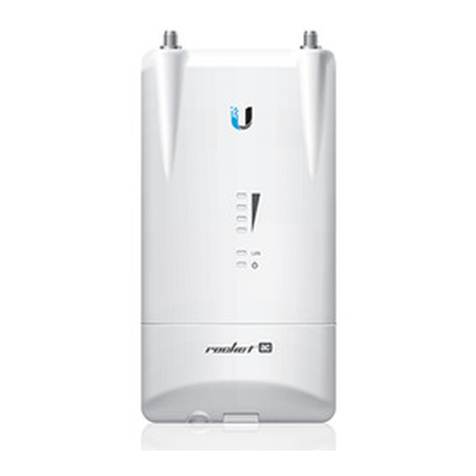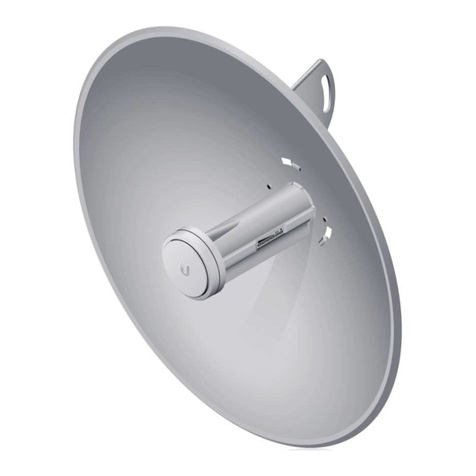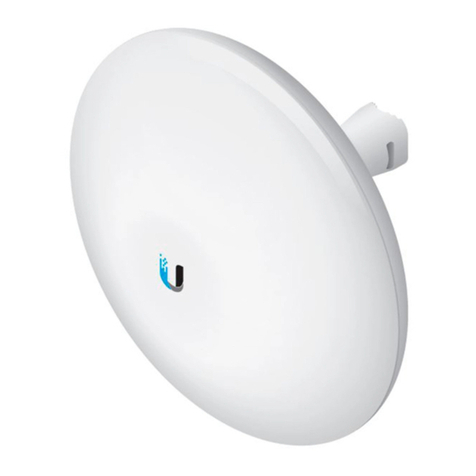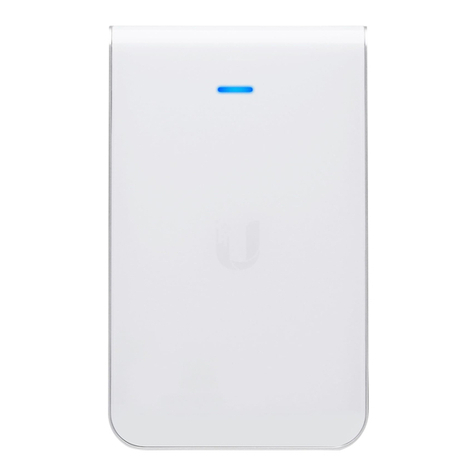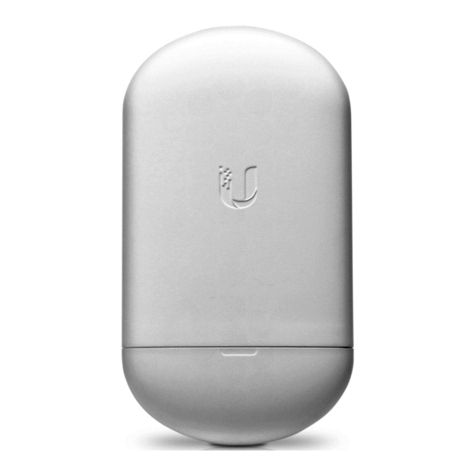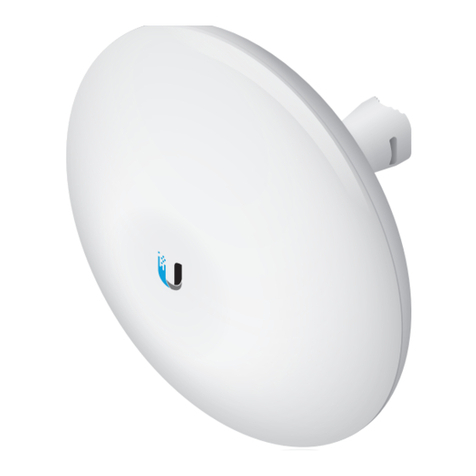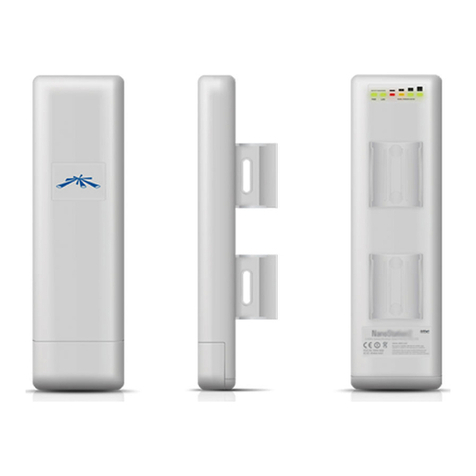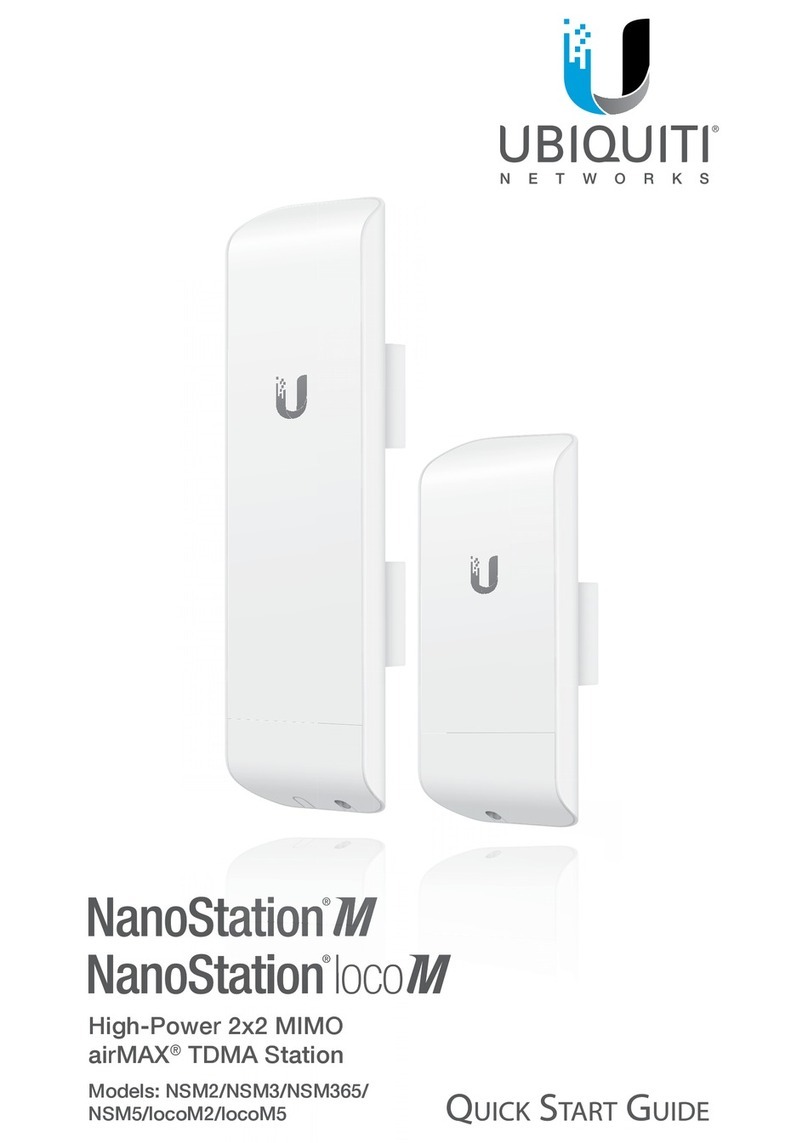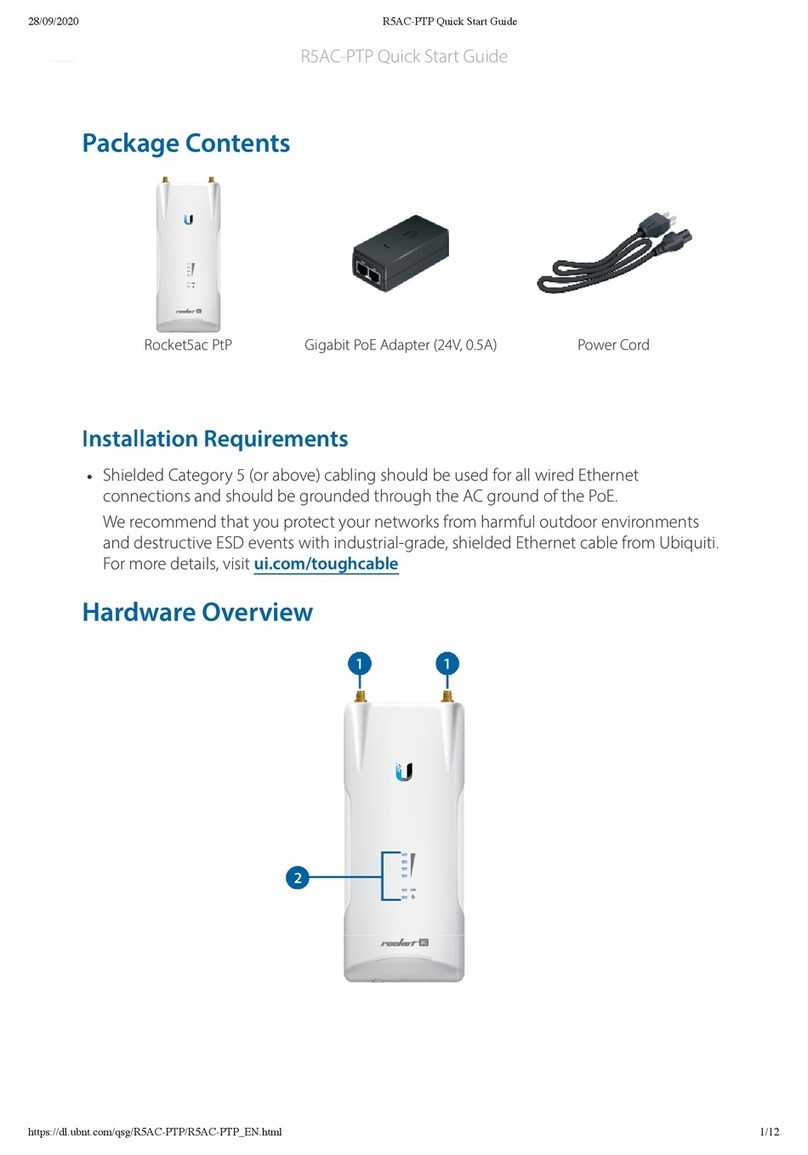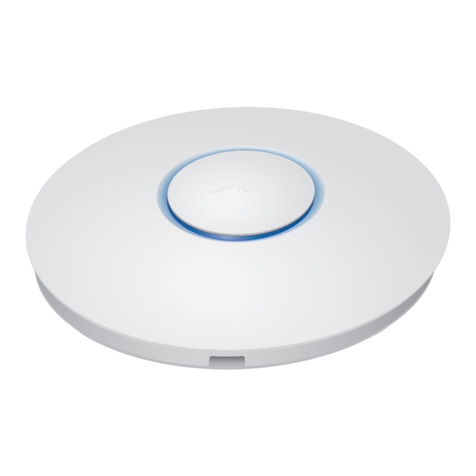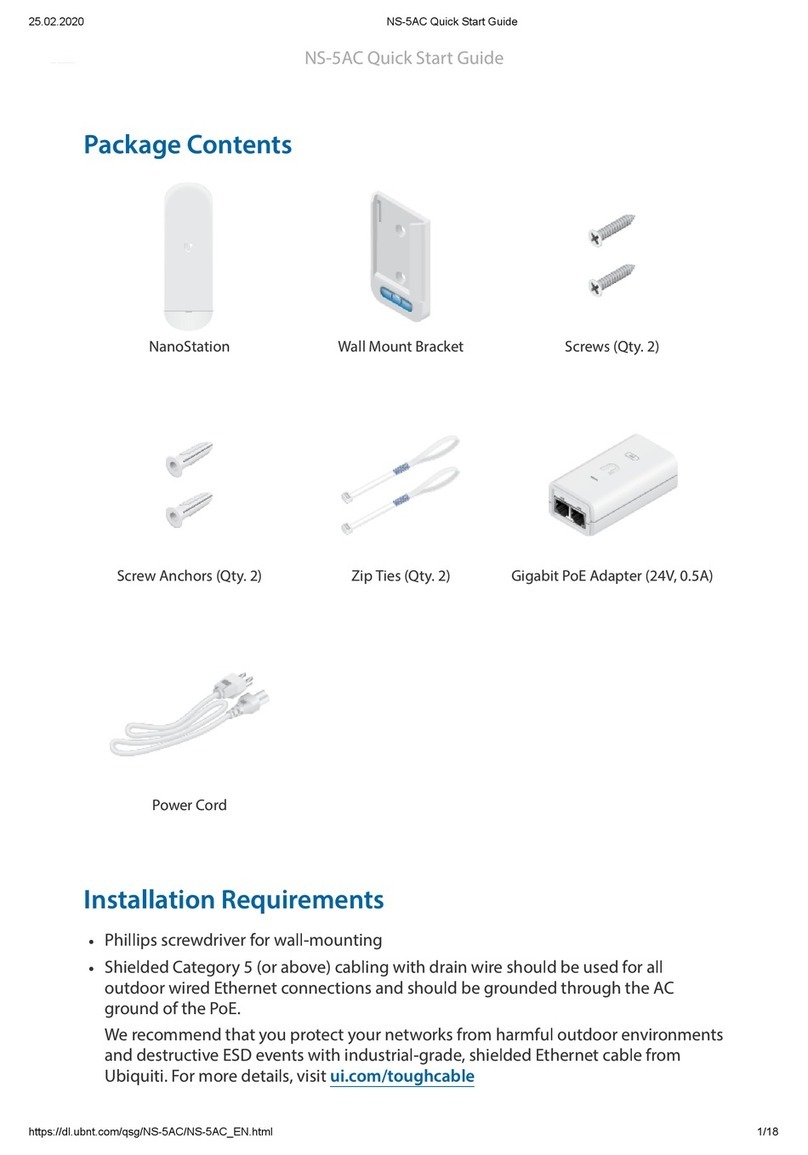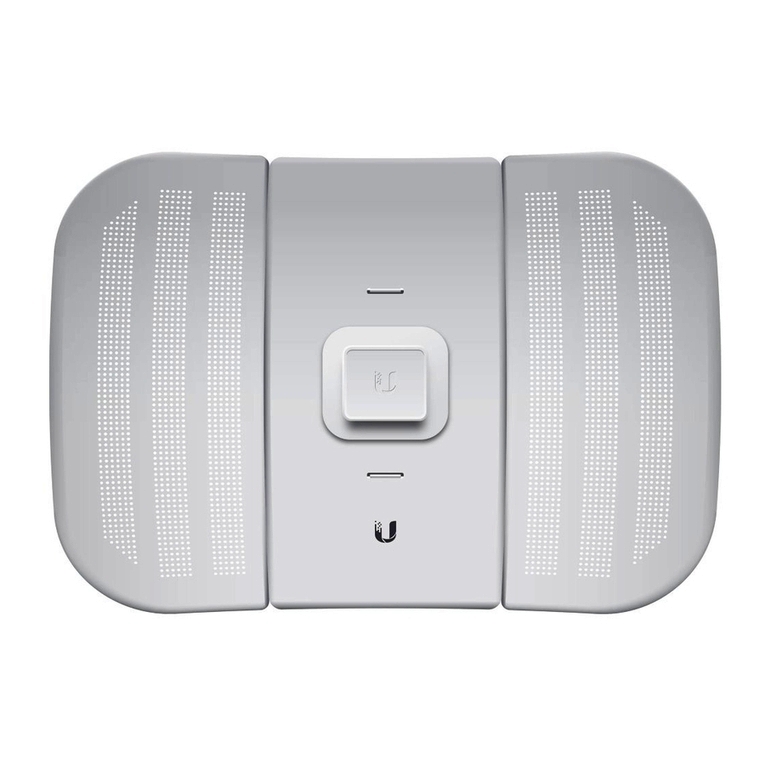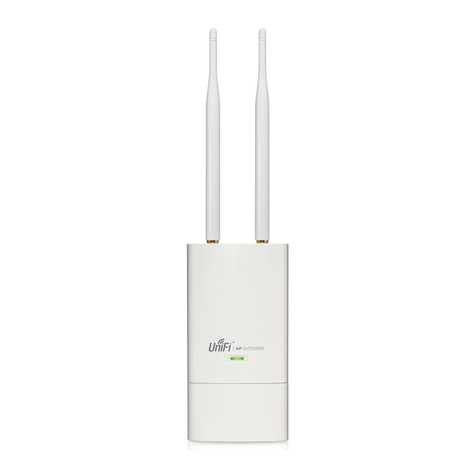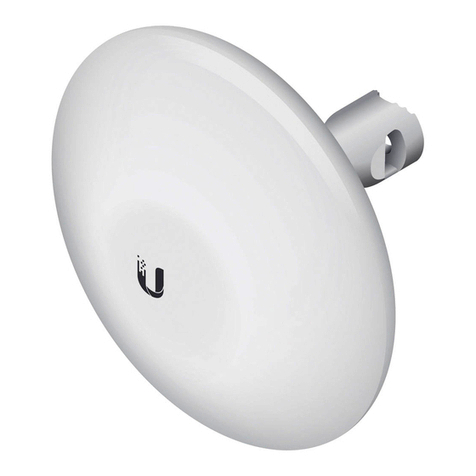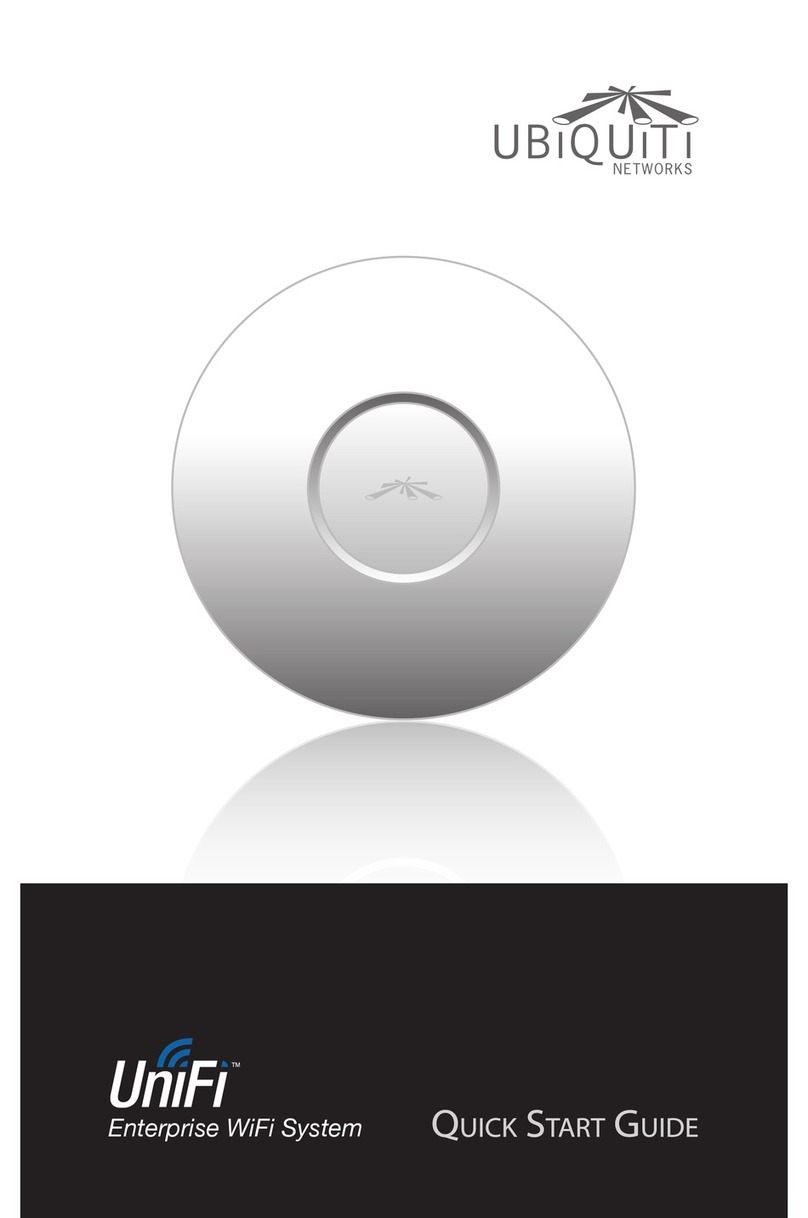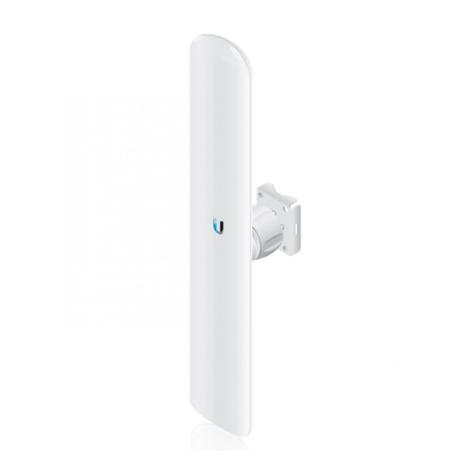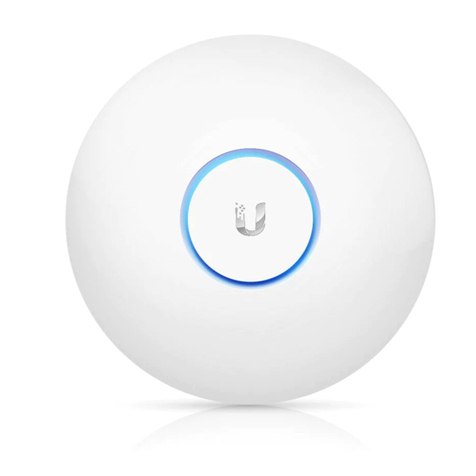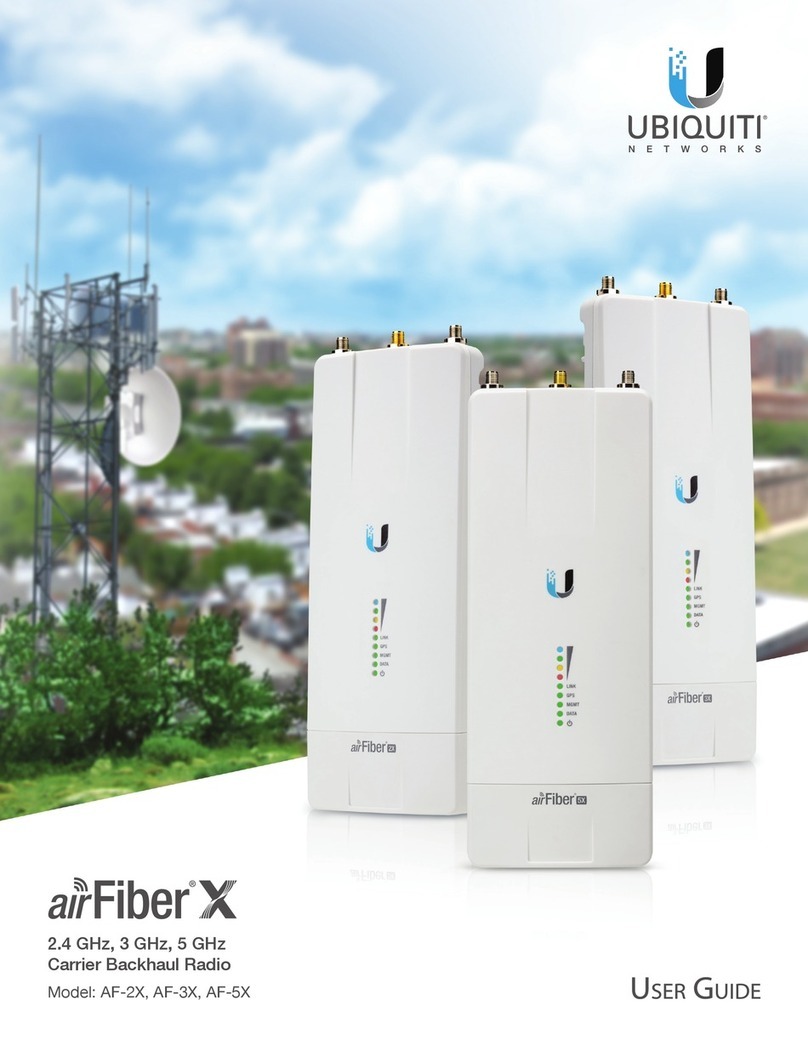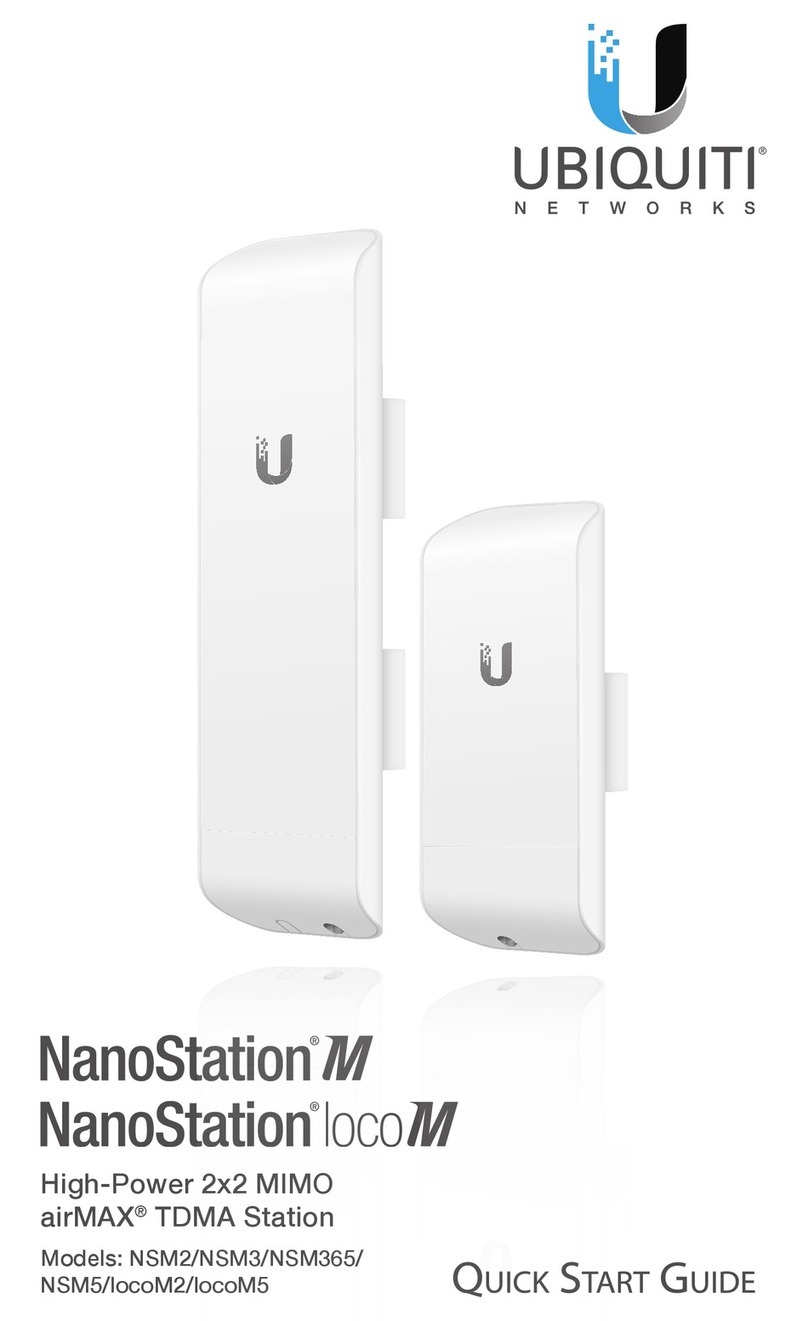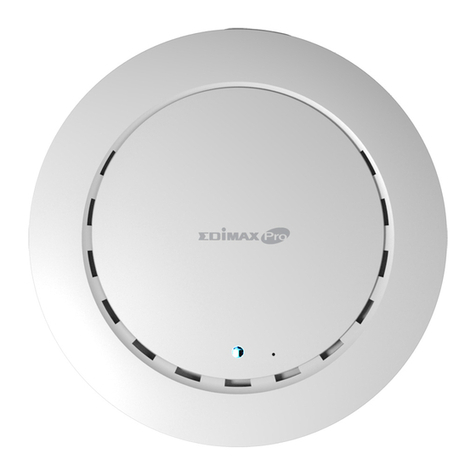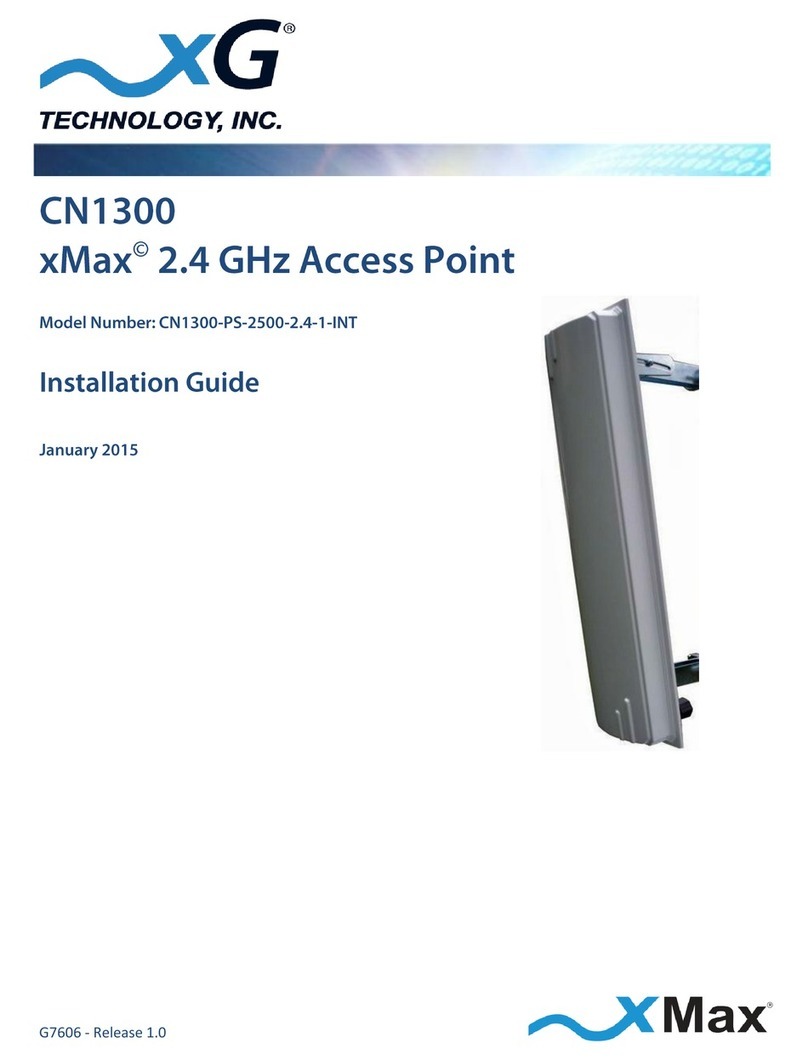
NanoBeamM5 Ball Joint Mount Lock Ring
Metal Strap PoE Adapter (24V, 0.5A) Power Cord
Reset Button
Ethernet Port
Power LED
Ethernet LED
Signal LEDs
Package Contents
Installation Requirements
The NanoBeam can be mounted on a pole or to a wall. A Metal Strap (included) is used
for pole-mounting. For wall-mounting, a suitable fastener such as a screw or bolt (not
included) is required.
7 mm socket wrench or screwdriver (for pole-mounting)
Wall fastener (for wall-mounting)
Shielded Category 5 (or above) cabling should be used for all wired Ethernet
connections and should be grounded through the AC ground of the PoE.
We recommend that you protect your networks from harmful outdoor environments and
destructive ESD events with industrial-grade, shielded Ethernet cable from Ubiquiti. For
more details, visit ui.com/toughcable
Hardware Overview
To reset to factory defaults, press and hold the Reset button for more than 10 seconds
while the device is powered on. Alternatively, the device may be reset remotely via a
Reset button located on the bottom of the PoE Adapter.
The Ethernet port is used to connect the power and should be connected to the LAN
and DHCP server. Power can be provided by any of the following:
PoE Adapter (included)
Ubiquiti TOUGHSwitch™ PoE
Ubiquiti EdgeRouter™ PoE
The Power LED will light blue when the device is connected to a power source.
The Ethernet LED will light steady blue when an active Ethernet connection is made
and flash when there is activity.
In airOS®, you can modify the wireless signal strength threshold values for each LED
on the Advanced tab under Signal LED Thresholds. The default values are shown
below:
Hardware Installation
Go to the appropriate mounting instructions: Pole Mounting or “Wall-Mounting”.
Pole-Mounting
1.
2. .
3.
4.
Wall-Mounting
The NanoBeam must be mounted directly to a wood stud or other structurally stable
surface to avoid damage to the mounting hole when you adjust the aim.
Optional Accessory
To enhance stability, you can use the NanoBeam Wall Mount Kit, model NBE-WMK (sold
separately).
Note: Center screw included. Two optional screws (not included) provide
additional stability.
Installation Instructions
1.
2.
3.
Fastener (not included)
OR
NanoBeam Wall Mount Kit
4.
Aiming
1.
2.
Connecting Power
1.
2.
3.
4.
OR
Accessing airOS
Verify connectivity in the airOS® Configuration Interface.
1. Make sure that your host machine is connected via Ethernet to the device.
2. Configure the Ethernet adapter on your host system with a static IP address on the
192.168.1.x subnet.
3. Launch your web browser and type https://192.168.1.20 in the address field. Press
enter (PC) or return (Mac).
4. Enter ubnt in the Username and Password fields. Select your Country and Language.
You must agree to the Terms of Use and the Ubiquiti Firmware License Agreement to
use the product. Click Login.
The airOS Configuration Interface will appear, allowing you to customize your settings as
needed. For additional details on the airOS Configuration Interface, refer to the User Guide
available at ui.com/download/airmax-m
You can also manage your device using the Ubiquiti Network Management System. Setup
using the UNMS™ app requires the U-Installer, sold separately.
Installer Compliance Responsibility
Devices must be professionally installed and it is the professional installer's responsibility
to make sure the device is operated within local country regulatory requirements.
The Output Power field is provided to the professional installer to assist in meeting
regulatory requirements.
Specifications
NBE-M5-16
Dimensions (Mount Included) 140 x 140 x 54 mm
(5.51 x 5.51 x 2.13")
Weight (Mount Included) 320 g
(11.3 oz)
Gain 16 dBi
Networking Interface (1) 10/100 Ethernet Port
Enclosure Outdoor UV Stabilized Plastic
Max. Power Consumption 6W
Power Supply 24V, 0.5A PoE Adapter (Included)
Power Method Passive PoE (Pairs 4, 5+; 7, 8 Return)
Wind Loading 21.4 N @ 200 km/h
(4.8 lbf @ 125 mph)
Wind Survivability 200 km/h
(125 mph)
Mounting Pole-Mount (Kit Included)
Wall-Mount
Salt Fog Test IEC 68-2-11 (ASTM B117),
Equivalent: MIL-STD-810 G Method 509.5
Vibration Test IEC 68-2-6
Temperature Shock Test IEC 68-2-14
UV Test IEC 68-2-5 at 40° C (104° F)
Equivalent: ETS 300 019-1-4
Wind-Driven Rain Test ETS 300 019-1-4
Equivalent: MIL-STD-810 G Method 506.5
Operating Temperature -40 to 70° C
(-40 to 158° F)
Operating Humidity 5 to 95% Noncondensing
Certifications CE, FCC, IC
Operating Frequency (MHz)
Worldwide 5150 - 5875
US/CA U-NII-1 5150 - 5250
U-NII-2A 5250 - 5350
U-NII-2C 5470 - 5725
U-NII-3 5725 - 5850
Safety Notices
1. Read, follow, and keep these instructions.
2. Heed all warnings.
3. Only use attachments/accessories specified by the manufacturer.
WARNING: Do not use this product in location that can be submerged by water.
WARNING: Avoid using this product during an electrical storm. There may be a remote risk
of electric shock from lightning.
Electrical Safety Information
1. Compliance is required with respect to voltage, frequency, and current requirements indicated on
the manufacturer’s label. Connection to a different power source than those specified may result in
improper operation, damage to the equipment or pose a fire hazard if the limitations are not
followed.
2. There are no operator serviceable parts inside this equipment. Service should be provided only by a
qualified service technician.
3. This equipment is provided with a detachable power cord which has an integral safety ground wire
intended for connection to a grounded safety outlet.
a. Do not substitute the power cord with one that is not the provided approved type. Never use an
adapter plug to connect to a 2-wire outlet as this will defeat the continuity of the grounding wire.
b. The equipment requires the use of the ground wire as a part of the safety certification,
modification or misuse can provide a shock hazard that can result in serious injury or death.
c. Contact a qualified electrician or the manufacturer if there are questions about the installation
prior to connecting the equipment.
d. Protective earthing is provided by Listed AC adapter. Building installation shall provide
appropriate short-circuit backup protection.
e. Protective bonding must be installed in accordance with local national wiring rules and
regulations.
Limited Warranty
ui.com/support/warranty
The limited warranty requires the use of arbitration to resolve disputes on an individual basis, and,
where applicable, specify arbitration instead of jury trials or class actions.
Compliance
FCC
Changes or modifications not expressly approved by the party responsible for compliance could void
the user’s authority to operate the equipment.
This device complies with Part 15 of the FCC Rules. Operation is subject to the following two
conditions.
1. This device may not cause harmful interference, and
2. This device must accept any interference received, including interference that may cause undesired
operation.
This equipment has been tested and found to comply with the limits for a Class A digital device,
pursuant to part 15 of the FCC Rules. These limits are designed to provide reasonable protection
against harmful interference when the equipment is operated in a commercial environment. This
equipment generates, uses, and can radiate radio frequency energy and, if not installed and used in
accordance with the instruction manual, may cause harmful interference to radio communications.
Operations of this equipment in a residential area is likely to cause harmful interference in which case
the user will be required to correct the interference at his own expense.
This radio transmitter has been approved by FCC.
ISED Canada
CAN ICES-3(A)/NMB-3(A)
This device complies with ISED Canada licence-exempt RSS standard(s). Operation is subject to the
following two conditions:
1. This device may not cause interference, and
2. This device must accept any interference, including interference that may cause undesired
operation of the device.
This radio transmitter has been approved by ISED Canada.
The device for operation in the band 5150-5250 MHz is only for indoor use to reduce the potential for
harmful interference to co-channel mobile satellite systems.
CAN ICES-3(A)/NMB-3(A)
Le présent appareil est conforme aux CNR d’ISDE Canada applicables aux appareils radio exempts
de licence. L’exploitation est autorisée aux deux conditions suivantes :
1. l’appareil ne doit pas produire de brouillage;
2. l’appareil doit accepter tout brouillage radioélectrique subi, même si le brouillage est susceptible
d’en compromettre le fonctionnement.
Le présent émetteur radio a été approuvé par ISDE Canada.
Les dispositifs fonctionnant dans la bande 5150-5250 MHz sont réservés uniquement pour une
utilisation à l’intérieur afin de réduire les risques de brouillage préjudiciable aux systèmes de satellites
mobiles utilisant les mêmes canaux.
IMPORTANT NOTE
Radiation Exposure Statement
This equipment complies with radiation exposure limits set forth for an uncontrolled environment.
This equipment should be installed and operated with minimum distance 34 cm between the
radiator and your body.
This transmitter must not be co-located or operating in conjunction with any other antenna or
transmitter.
AVIS IMPORTANT
Déclaration sur l’exposition aux rayonnements
Cet équipement est conforme aux limites prévues pour l’exposition aux rayonnements dans un
environnement non contrôlé.
Lors de l’installation et de la mise en fonctionnement de l’équipement, assurez-vous qu’il y ait une
distance minimale de 34 cm entre l’élément rayonnant et vous.
Cet émetteur ne doit être installé à proximité d’aucune autre antenne ni d’aucun autre émetteur, et
ne doit être utilisé conjointement à aucun autre de ces appareils.
Australia and New Zealand
Warning: This equipment is compliant with Class A of CISPR 32. In a residential environment
this equipment may cause radio interference.
Brazil
Nota: Este equipamento não tem direito à proteção contra interferência prejudicial e não
pode causar interferência em sistemas devidamente autorizados.
CE Marking
CE marking on this product represents the product is in compliance with all directives that are
applicable to it.
NBE-M5-16 Quick Start Guide
